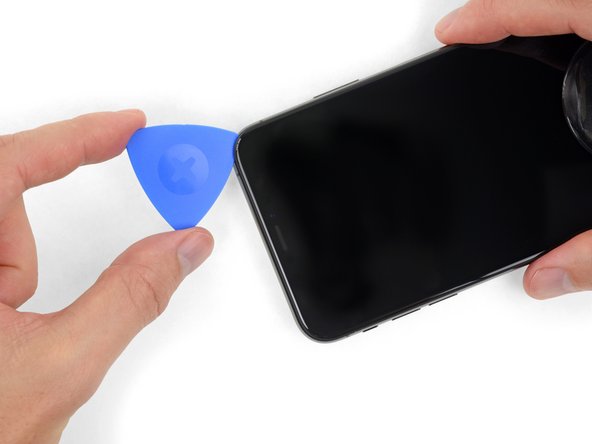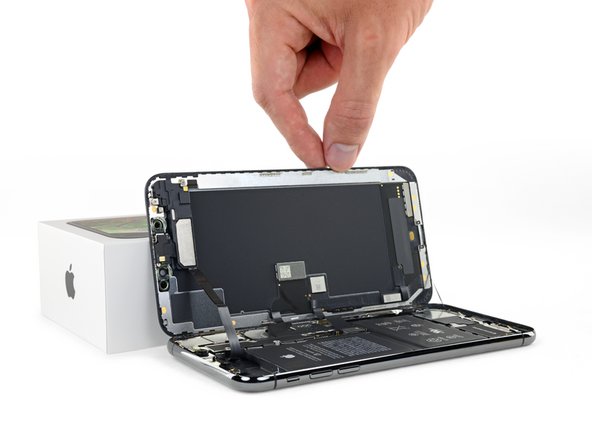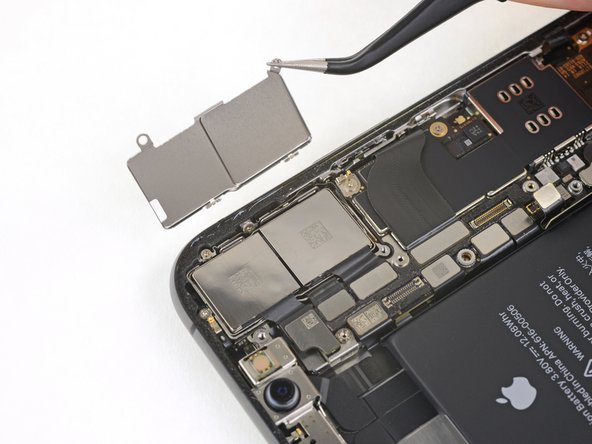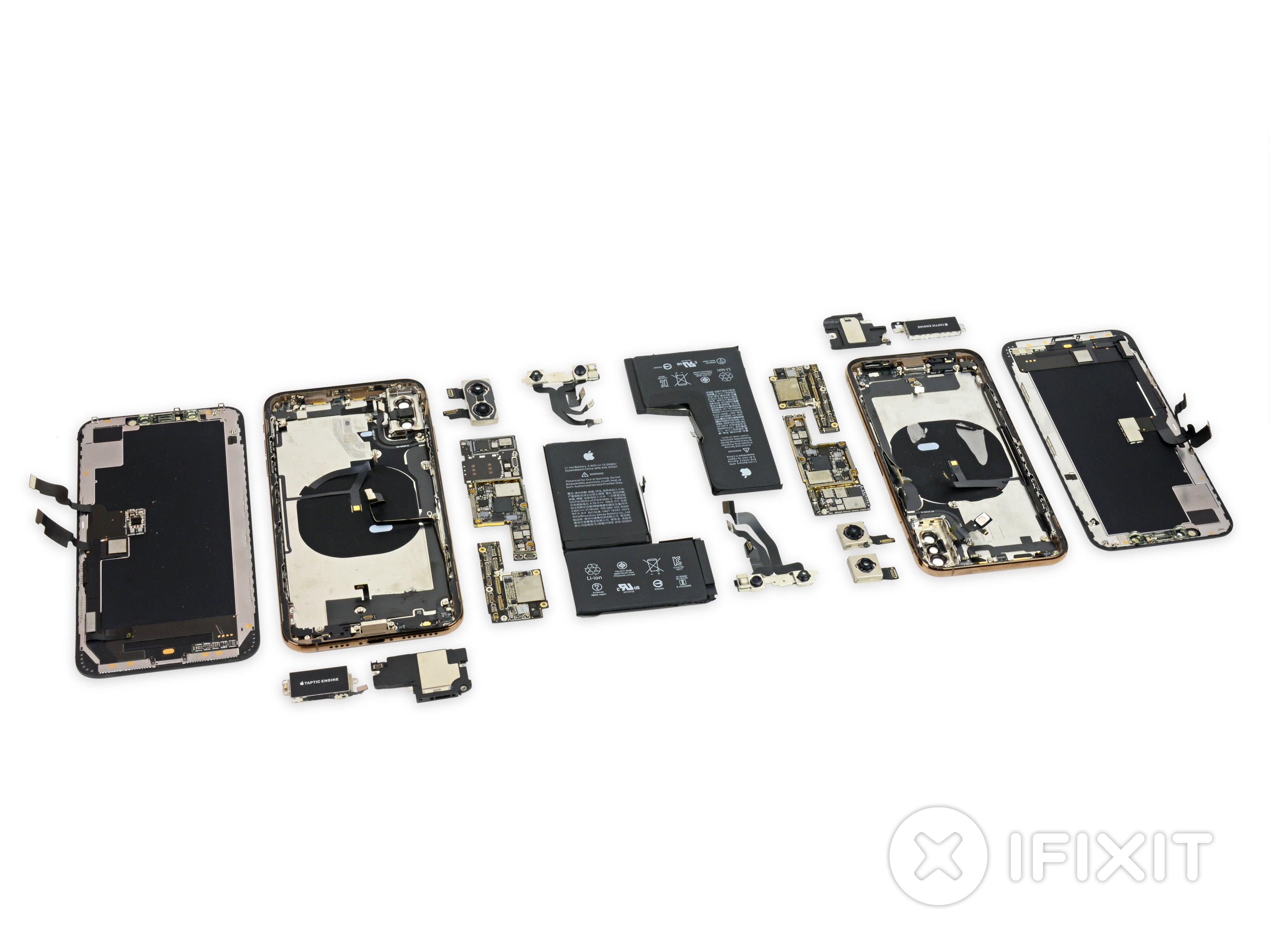iPhone XS Max Rear-Facing Cameras Replacement
Duration: 45 minutes
Steps: 30 Steps
Follow this guide to remove and swap out the rear cameras on your iPhone XS Max. The rear camera setup includes two separate parts: a wide-angle lens and a telephoto lens. Both come as one unit when replacing. Good news — the cameras used in both the iPhone XS and XS Max are the same, so you can switch parts between these models without a hitch. Heads up: this guide walks you through fully disconnecting the display cables and taking off the display assembly for easier access to the cameras. But if you're feeling confident and careful, you can skip disconnecting the display cables to save time—just make sure the display stays supported and the cables stay safe.
Step 1
Before you get started, make sure your iPhone's battery is under 25%. Lithium-ion batteries can be a little dramatic if punctured while fully charged – they might catch fire or even explode! Better safe than sorry!
- First things first, power down your iPhone before you dive into the repair process. Safety first!
- Unscrew the two 6.9 mm pentalobe screws at the bottom of your iPhone—this part is easier than it sounds, promise!
- Keep in mind, opening up your iPhone’s display will mess with its waterproof seals. Make sure you've got replacements on hand before you go any further, or be extra careful with water exposure if you plan to put it back together without new seals.
Step 2
Pushing your opening pick in too deep can mess things up—let’s keep it safe by marking your pick before you start.
Feel free to mark other corners of the pick with different depths to keep track.
Or, get creative and tape a coin 3 mm from the tip to serve as a handy depth stop.
- Grab your opening pick and make a mark with a permanent marker exactly 3 mm from the tip—think of it as your trusty reference line for the next moves.
Step 3
Pop on some safety glasses—your eyes don’t need a surprise glass confetti party during this repair.
Got a cracked screen on your iPhone? No worries! Just tape over that glass to keep it from shattering further and to protect yourself while you tackle the repair.
If you're really in a bind, a little superglue on the suction cup can help it stick to the screen while you work your magic.
- Cover the iPhone's screen with overlapping strips of clear packing tape until the entire front is protected.
- If the suction cup won't stick in the upcoming steps, try folding a sturdy piece of tape (like duct tape) into a little handle and use that to lift the screen instead.
Step 4
The next three steps walk you through the Anti-Clamp, a handy tool we created to make opening your device a breeze. If you’re not using the Anti-Clamp, no worries—just skip ahead three steps for another way to get it done.
For a full breakdown on how to use the Anti-Clamp, check out this guide.
If your iPhone’s surface is feeling a bit too slick for the Anti-Clamp to grip, try adding some tape to give it a better hold.
- Pull the blue handle back to release the Anti-Clamp's arms.
- Slide the arms onto either the left or right side of your iPhone.
- Place the suction cups near the bottom edge of the iPhone—one on the front and one on the back.
- Press the cups together to create a good seal and get that suction going.
Step 5
- Slide that blue handle forward—arms locked and loaded!
- Give the handle a full spin clockwise (yep, 360 degrees) or until you see those suction cups start to stretch.
- Keep those suction cups lined up like dance partners. If they start to drift apart, just loosen things up a touch and bring them back in sync.
Step 6
Take it easy and don't go overboard with the turns. Just a quarter turn at a time, then pause for about a minute to let the Anti-Clamp and a little time do their thing. Patience is key, your device will thank you.
You can try using a hair dryer, heat gun, or hot plate to warm things up—but watch out! Too much heat might harm the screen or battery, so take it easy.
If the Anti-Clamp isn’t opening enough of a gap, give the area a little more heat and twist the handle about a quarter turn to help things along.
- Warm up an iOpener and slip it through the arms of the Anti-Clamp.
- Bend the iOpener so it rests on the bottom edge of your iPhone.
- Take a minute to let the adhesive loosen up and form a gap that will make your life easier.
- Slide an opening pick into the gap between the screen and the plastic bezel (but definitely not the screen itself).
- Go ahead and skip the next three steps.
Tools Used
Step 7
Warming up the lower edge of your iPhone is a clever way to loosen the adhesive holding the display in place, making it much simpler to open. Let's get that screen free with a bit of heat!
- Grab a hairdryer or heat gun, or get your hands on an iOpener. Now, gently warm up the lower edge of the iPhone for about a minute. This little warm-up will help soften that pesky adhesive hiding underneath.
Tools Used
Step 8
- When using a single suction handle, stick it to the bottom edge of the phone—just steer clear of the curved glass area to get the best grip.
Tools Used
Step 9
The adhesive holding the display is tough, so creating an initial gap requires a bit of muscle. If you're struggling to get it started, heat things up a little more, and gently rock the screen up and down. This will weaken the adhesive just enough to create the space you need to slip in your tool.
- Grab the suction cup and give it a steady, firm pull to make a little gap between the front panel and the back case. You're almost there!
- Slip an opening pick into the gap under the screen and the plastic bezel – just avoid the screen itself. Be gentle and take your time!
Step 10
Be careful not to push your pick in more than 3 mm—anything deeper could mess with the internals. Keep it gentle, you're almost there!
- Take your opening pick for a stroll around the lower left corner, then cruise up the left side of your iPhone, gently slicing through the adhesive that’s keeping the display stuck in place.
Step 11
Be careful! There are some sensitive cables hanging out along the right edge of your iPhone. It's best to steer clear of this area with your pick, or you might end up giving those cables an unwanted haircut.
Step 12
Be careful not to insert your pick more than 3 mm deep—you don't want to accidentally mess with the display cables.
- Grab your pick, slide it back in at the bottom edge of your iPhone, then cruise up the right side to keep peeling that adhesive away. Keep it smooth and steady!
Step 13
Go easy on those clips! Too much force and they'll snap. Patience is your best friend here.
Don't push your pick in more than 3 mm – you don't want to accidentally mess with that delicate front panel sensor array.
The top edge of the display is held in place by a combo of glue and clips, so take your time peeling it back gently.
- Glide your opening pick along the top corner of the display—give it a gentle tug or a little wiggle toward the Lightning port. Treat it like you're coaxing a stubborn sticker off your notebook.
- Now, swing that pick over to the other corner and slice through any leftover adhesive holding the display down. Smooth moves all the way to victory!
Step 14
- Give that little nub on the suction cup a gentle pull to release it from the front panel. Easy does it, and you're good to go!
Step 15
Hold up before you try to separate the display all the way! There are some delicate ribbon cables still connecting it to the logic board, so take it slow and steady.
- Time to open up that iPhone! Just swing the display up from the left side, like you're flipping open a book. Easy peasy!
- Once it's open, lean the display against something sturdy to keep it in place while you work your magic on the phone.
- When you're putting it back together, lay the display back in position, making sure to align those clips along the top edge. Gently press that top edge into place and then give the rest of the display a little snap down. If it’s not clicking into place smoothly, take a quick peek at those clips around the edge and ensure they’re not bent out of shape.
Step 16
As you go through this repair, make sure to keep all your screws organized and remember exactly where each one belongs. This will help you avoid any headaches and make sure your iPhone gets back to looking and working like new!
- Let's get those screws out! First up, grab your trusty Y000 screwdriver and tackle those four screws holding the logic board cover bracket in place. Here's what you'll need to find:
- Two screws that are 1.1 mm long
- One screw that's 1.5 mm long
- And one slightly longer screw at 3.7 mm
- Once you've got those out, you're one step closer to getting in there!
Step 17
The bracket might be a bit clingy—just give it a gentle lift and it’ll let go. No need to wrestle; steady hands win the day!
- Take out the bracket—no need for a dramatic exit.
- Before sealing up your iPhone, switch it on and make sure everything's working. Once you've checked all the functions, power it down completely before moving on.
Step 18
Be careful not to mess up the black silicone seal that hugs this and other board connections. These little guys are your best friends when it comes to keeping water and dust at bay!
- Gently use a spudger or even a clean fingernail to lift the battery connector out of its socket on the logic board.
- Carefully bend the connector a little away from the logic board so it doesn’t accidentally touch the socket and power up the phone while you’re working.
Tools Used
Step 19
- Time to show those Y000 screws who's boss! Unscrew the three holding down the display connector bracket:
- Two are 1.5 mm—easy to spot.
- The sneaky one is 1.1 mm—keep an eye on it!
Step 20
- Pop off the bracket and set it aside. You're one step closer!
Step 21
- Gently pop off the front panel sensor assembly connector using the tip of a spudger or your fingernail. Easy does it!
Tools Used
Step 22
- Gently pop off the OLED panel cable connector using a spudger or your fingernail. No need to Hulk out—easy does it!
- When reconnecting, line up the press connector, tap down one side until you hear a click, then do the same for the other side. Skip pressing in the middle—those tiny pins don’t do well with roughhousing. Misalignment can bend the pins, and that’s just bad news for your device.
Tools Used
Step 23
- Gently pop up the digitizer cable connector from its socket using a spudger or your fingernail—think of it as opening a stubborn pickle jar, but with more precision.
- If your screen acts like it's ignoring you after the repair, unplug the battery and reconnect this cable. Make sure it clicks in tight and there's no dust hanging around in the socket. That little snap is the sound of success!
Tools Used
Step 24
The front panel sensor assembly flex cable has a bit of stick to it—think of it as a gentle hug holding things together.
- Gently lift the cable and give it a little nudge until the adhesive decides to let go.
Step 25
- Lift off the display assembly—like opening a treasure chest, but with more screws.
- Thinking about keeping your device waterproof? Now’s your chance to swap out that adhesive around the edges before you put it all back together.
Step 26
- Take out those two 1.8 mm Phillips screws that are holding the rear camera cover in place. You've got this!
Step 27
If the two tabs aren't lined up just right, the cover won't sit flush. Make sure everything clicks into place!
- Start by gently lifting the camera cover from the edge nearest the battery. It should pop right off!
- When you're ready to put the camera cover back on, just reverse the fun! First, lower the outer edge until those little tabs on the cover click snugly into the bracket around the camera module. Then, simply hinge the cover back into place.
Step 28
- Grab an opening tool or just use your fingernail to pop those two camera cables up and out of their sockets. Easy does it—lift them straight up!
Tools Used
Step 29
The camera assembly is snugly fit into place without any glue holding it down. You might find that a spudger or plastic pry tool isn’t quite strong enough to wiggle it free, so be prepared for a bit of a challenge!
Step 30
- Line up your new part with the original one—sometimes you’ll need to move over a few bits or peel off protective layers before popping it in place.
- Put your device back together by reversing the steps above—easy does it!
- Got old electronic parts? Take them to an R2 or e-Stewards certified recycler to keep things green.
- If things didn’t go as planned, swing by our Answers community for some troubleshooting tips, or if it’s really tricky, you can always schedule a repair.













































































